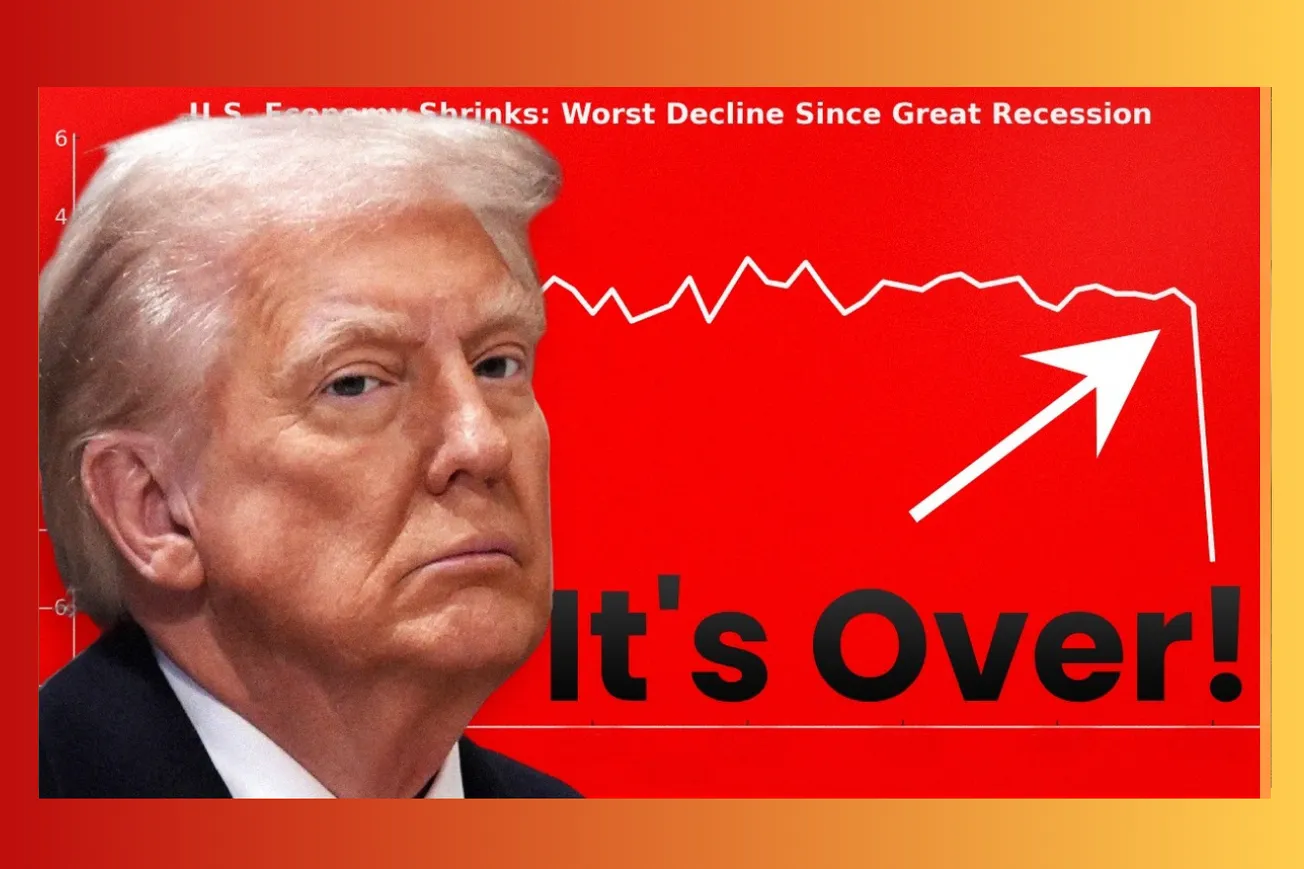Table of Contents
Three policy experts conduct their quarterly "Are we cooked?" assessment, finding short-term indicators improving while long-term structural damage to America's competitive advantages accelerates under Trump.
Key Takeaways
- Short-term indicators look better than expected - stock markets rebounded after Trump backed down from major tariff threats
- The dollar has declined 5-6% since the last assessment, suggesting gradual erosion of confidence in US economic leadership
- Most of Trump's Liberation Day tariffs are likely illegal and may be overturned by courts, creating earnings shifts for affected companies
- AI talent, not hardware, has become the real bottleneck - and America's immigration restrictions threaten this advantage
- University funding cuts and attacks on foreign students could permanently damage America's research ecosystem
- Europe and other allies are beginning to hedge against dollar dependence, exploring alternative financial arrangements
- Manufacturing renaissance rhetoric isn't backed by actual investment data, which peaked in mid-2024 and is declining
- Statistical agencies face budget cuts that could undermine the data quality needed to assess America's actual performance
- The administration shows tactical flexibility on immediate crises while maintaining strategic hostility to long-term competitive advantages
- A "Brexit-style" gradual decline rather than immediate catastrophe appears to be the most likely trajectory
The Quarterly Reality Check: Mixed Signals Everywhere
Every quarter now, it seems, American policy watchers find themselves asking the same fundamental question: "Are we cooked?" It's become a darkly humorous ritual for tracking whether the Trump administration's policies are fundamentally undermining America's long-term competitiveness and global position.
The short-term indicators offer some genuine relief. Trump backed down from his most dramatic tariff threats after they caused significant market turmoil in April. The stock market rebounded strongly once investors realized the apocalyptic trade war scenarios weren't materializing. He can still post memes about bombing Iran and largely get away with it politically, suggesting his base remains satisfied with symbolic rather than substantive action.
But this tactical flexibility on immediate crises masks deeper strategic damage to the foundations of American power. The core drivers of American success over the past century - massive investment in scientific R&D, attracting global talent to American universities and companies, and maintaining the institutional credibility that underpins dollar dominance - are all under sustained attack.
The paradox is striking: precisely because Trump has avoided immediate economic catastrophe, there's less pressure to reverse the longer-term policies that could prove far more damaging over decades. It's the Brexit dynamic playing out in real time - not immediate crisis, but persistent degradation of competitive advantages.
- Market recovery after tariff threats suggests Trump will retreat from policies with immediate economic costs
- Immigration restrictions and university attacks continue despite lacking immediate visible impact
- Dollar decline accelerates while receiving minimal media attention compared to dramatic policy announcements
- Tactical flexibility on crises enables strategic persistence on structurally damaging policies
The challenge is that the most important metrics for long-term American competitiveness - research output, talent attraction, institutional credibility - operate on timescales that don't align with quarterly market assessments or political news cycles.
The Dollar's Quiet Decline: Voting with Their Wallets
While headlines focus on tariffs and trade wars, a more fundamental shift is occurring largely below the radar: the gradual erosion of dollar dominance in global finance. Since the last quarterly assessment, the dollar has declined another 5-6%, representing what Kevin Xu calls the world "voting with their feet" on American leadership credibility.
This isn't the dramatic collapse that some predicted immediately after Liberation Day, but rather a steady drift that reflects changing calculations about long-term American stability. The pattern mirrors other metrics where the immediate damage was overstated but the persistent erosion proves more significant over time.
Several data points suggest this trend has legs beyond normal currency fluctuations. Central banks worldwide have dramatically increased gold purchases as a hedge against dollar exposure. More symbolically, European countries are actively debating whether to repatriate gold reserves currently stored in Manhattan vaults, citing concerns about American custodial reliability.
Perhaps most significantly, China has begun actively promoting renminbi settlement in situations where dollar-based trade is becoming less attractive. This isn't about replacing the dollar as global reserve currency - a massive undertaking that China isn't eager to attempt - but rather creating alternatives in specific trade corridors where dollar dependence creates vulnerabilities.
- Dollar decline accelerates despite lacking the dramatic policy triggers that captured initial attention
- Central bank gold buying reflects systematic hedging against dollar exposure rather than speculative trading
- European allies question American reliability even for basic custodial services like gold storage
- China pursues targeted alternatives to dollar settlement rather than comprehensive replacement strategy
The broader pattern suggests that while America can still extract significant economic advantages from dollar dominance, the margins are eroding. Countries and companies are building redundancy into their financial arrangements, reducing their dependence on American-controlled systems even when they continue using them for routine transactions.
AI and the Talent Bottleneck: Missing the Forest for the Trees
Perhaps nowhere is the gap between rhetoric and reality more pronounced than in artificial intelligence policy. The administration talks extensively about AI leadership while systematically undermining the talent pipeline that actually drives AI innovation.
The conventional wisdom that compute power and hardware access determine AI leadership is increasingly outdated. As Kevin Xu observes, "GPU is not a scarcity anymore" - companies with sufficient capital can access whatever Nvidia hardware they need. The real constraint has shifted to human talent, particularly the small number of researchers capable of breakthrough work.
This makes America's immigration restrictions and university attacks particularly self-defeating. The administration is simultaneously trying to win an AI competition while driving away the international talent that has historically powered American technological advantages. Research grants are being cut based on keyword searches for terms like "diversity" or "transgender" - even when those words appear in contexts like neurotransmitter research.
The contrast with competitor strategies is stark. China's DeepSeek achieved remarkable results through what Xu calls a "pure scouting and drafting" approach - identifying and developing young talent domestically. Meanwhile, Meta is pursuing a "buy the free agent market" strategy, poaching talent from competitors with massive salary offers. Both approaches require deep talent pools, but America is actively shrinking its pool through policy choices.
- Hardware scarcity has ended but talent scarcity has intensified, making immigration policy crucial for AI leadership
- Research grant cuts based on ideological keyword searches undermine scientific talent attraction
- Competitor countries are investing heavily in talent development while America restricts talent inflows
- The most innovative AI companies succeed through talent aggregation strategies that require deep global recruitment
The irony is that the researchers most likely to emigrate from their home countries to pursue cutting-edge work are precisely those who want to escape ideological constraints on scientific inquiry. By imposing similar constraints, America risks forfeiting one of its primary competitive advantages.
The University Wars: Attacking American Soft Power Infrastructure
American universities represent one of the country's most successful and underappreciated soft power assets. Despite their flaws and recent controversies, they remain magnets for global talent and drivers of scientific innovation that competitors struggle to replicate. The Trump administration's "war on universities" threatens to dismantle this advantage for ideological reasons that have little connection to actual American interests.
The attacks operate on multiple fronts simultaneously. Federal research funding faces cuts based on ideological keyword searches rather than scientific merit. Foreign student enrollment is being restricted through visa policies and hostile rhetoric. University endowments face punitive taxation that threatens their operating models. Some institutions are being pressured to fire leadership for political reasons.
The historical context makes this particularly shortsighted. American universities weren't always globally dominant - before 1933, German was the dominant academic language and European institutions led most fields. American university excellence was built deliberately through sustained investment and commitment to attracting global talent. It's not an inherent advantage that survives regardless of policy choices.
The talent pipeline effects are already visible. International applications to American graduate programs are declining, while applications to Canadian, Australian, and European alternatives increase. Established researchers are increasingly hesitant to collaborate with American institutions given uncertainty about funding and political interference.
- American university dominance is historically recent and required deliberate policy choices to build
- Multiple simultaneous attacks - funding cuts, visa restrictions, tax penalties - create compounding damage
- International talent is already shifting toward alternative destinations with more predictable environments
- Research collaboration networks face disruption as international partners hedge against American policy instability
The administration seems to view universities primarily through a domestic political lens, missing their crucial role in maintaining American technological and scientific leadership. This represents a classic case of sacrificing long-term competitive advantages for short-term political symbolism.
Tariff Theater: Legal Challenges and Market Reality
The Trump administration's most dramatic trade policy tool - sweeping tariffs imposed under emergency authorities - faces significant legal challenges that could reshape the entire trade landscape. Most of the Liberation Day tariffs that caused market turmoil in April were imposed under a 1977 emergency statute previously used only for sanctions, never for general trade policy.
According to Peter Harrell, who tracks these cases closely, the legal foundation is shaky. A specialty court has already ruled against the administration, though that decision is on hold pending appeals. The Federal Circuit will hear arguments on July 31st, with a decision expected by August and Supreme Court review likely in the fall. The betting odds favor the administration losing on the merits.
If the tariffs are found illegal, companies that paid them would be entitled to rebates - creating an unusual earnings pattern where 2025 looks better retroactively than it does in real time. But this wouldn't end all tariffs, just those imposed under emergency authorities. The administration would likely scramble to recreate tariffs under other legal frameworks, though with different scope and timing.
The broader pattern suggests that Trump's most dramatic economic policies face institutional constraints that limit their implementation. Courts, Congress, and market reactions create feedback loops that encourage tactical retreats from the most extreme positions.
- Most Liberation Day tariffs likely violated statutory authority limits and may be overturned
- Legal challenges create unusual financial dynamics with potential retroactive earnings impacts
- Institutional constraints force tactical retreats from most extreme trade policies
- Administration shows willingness to back down when faced with immediate economic or legal costs
This represents both good news and bad news for American economic stability. The immediate damage is less than feared, but the pattern of pushing boundaries until forced to retreat creates ongoing uncertainty that undermines business planning and international confidence.
Alliance Management: Tactical Improvements, Strategic Questions
Trump's approach to alliance relationships shows the same pattern of tactical flexibility masking strategic uncertainty. After deeply troubling rhetoric toward NATO allies and Ukraine in the first quarter, recent months have seen notable improvements in tone and substance.
The NATO summit produced agreements that essentially gave Trump what he wanted - increased European defense spending - while allowing all parties to claim victory. The administration's relationship with Zelenskyy has notably warmed, with Trump even claiming that Putin called asking for help mediating with Israel. These represent genuine improvements from the confrontational stance of earlier months.
However, these improvements may reflect Trump's tactical flexibility rather than fundamental strategic shifts. His praise for Canadian Prime Minister Carney two weeks ago has already reverted to calling Canada "the worst" and threatening new tariffs. The pattern suggests that positive developments shouldn't be assumed to be permanent.
The more concerning trend involves Asian allies, where America's Middle East focus may be creating strategic drift. Japan was sufficiently frustrated with American behavior to cancel a planned two-plus-two dialogue - a significant diplomatic rebuke that received little attention. The Iran bombing demonstrates American willingness to use force but also signals renewed Middle East prioritization that could come at Asian allies' expense.
- NATO relationships have improved through agreements that satisfy Trump's stated demands
- Ukraine relationship has warmed considerably from earlier confrontational stance
- Asian alliances show more strain as Middle East priorities compete for attention
- Tactical improvements may not reflect stable strategic commitments given Trump's pattern of reversals
The challenge for allies is developing strategies that can survive Trump's oscillating attention and priorities. European NATO countries appear to have found a formula that works, but Asian allies face greater uncertainty about American strategic commitment.
The Manufacturing Renaissance That Isn't
Despite extensive rhetoric about American manufacturing revival, the actual data tells a different story. Manufacturing investment peaked in mid-2024 and has been declining since. The administration talks about strategic industries and domestic production while simultaneously cutting the programs that were driving actual manufacturing investment.
The previous administration's CHIPS Act and Inflation Reduction Act were generating real manufacturing investment in semiconductors, batteries, and clean energy technologies. The current administration is systematically gutting these programs while promising alternative approaches that haven't materialized in investment data.
The Department of Energy's loan programs, which supported both clean energy and critical minerals development, face dramatic cuts. This matters beyond environmental concerns because these programs were also addressing strategic supply chain vulnerabilities that the administration claims to prioritize. When funding disappears, strategic concerns become irrelevant regardless of rhetorical commitments.
Oil and gas drilling, supposedly unleashed by deregulation, faces market rather than regulatory constraints. Shell companies don't want to increase drilling at current prices, especially when tariffs have increased their steel costs substantially. The regulatory environment is less important than basic economic fundamentals that aren't favorable for expanded domestic production.
- Manufacturing investment data shows decline rather than renaissance despite rhetorical promises
- Previous administration's industrial programs drove actual investment that current administration is eliminating
- Oil and gas companies face market constraints that regulation changes don't address
- Strategic supply chain concerns aren't being addressed through actual policy implementation
The gap between rhetoric and reality suggests that the administration prioritizes political symbolism over actual industrial development. This creates uncertainty for companies considering long-term manufacturing investments in the United States.
The Data Integrity Question: Losing the Ability to Measure Progress
A less visible but potentially crucial development involves systematic cuts to the statistical agencies that provide the data needed to assess economic performance. The Bureau of Labor Statistics, Bureau of Economic Analysis, and Census Bureau all face budget pressures that could undermine data quality and availability.
Some degradation predates the current administration - survey response rates have been declining for years, creating challenges for employment and inflation measurement. But targeted cuts to statistical capacity could accelerate these problems while making it harder to identify and address them.
The concern isn't necessarily that numbers will be deliberately falsified, but that budget constraints could force discontinuation of important data series or reduce sampling quality to the point where numbers become unreliable. Matt Klein notes that some statistical tables have already been discontinued due to funding constraints, and advisory committees that ensure data quality have been eliminated.
This creates a potential scenario where America begins resembling other countries where official statistics are viewed with skepticism. The institutional credibility of American data has been a significant advantage for policy making and international confidence - an advantage that could erode quickly if not maintained deliberately.
- Statistical agencies face budget cuts that could undermine data quality and availability
- Survey response rates were already declining before targeted budget pressures
- Advisory mechanisms for ensuring data quality have been eliminated or reduced
- American data credibility represents an institutional advantage that requires active maintenance
The irony is that precisely when America needs high-quality data to assess policy effectiveness, the administration is reducing the capacity to generate that data. This could create a feedback loop where policy failures become harder to identify and correct.
The Brexit Analogy: Gradual Decline vs. Immediate Crisis
The most useful framework for understanding current American trajectory may be the Brexit experience. Before the UK's EU referendum, critics warned of immediate catastrophe if voters chose to leave. When immediate catastrophe didn't materialize, Brexit supporters claimed vindication. But the more accurate prediction was that everything would simply be persistently worse over time - and that has proven correct.
America appears to be following a similar pattern. The most dramatic Trump policies face institutional constraints that prevent immediate economic crisis. Markets rebound when the most extreme scenarios don't materialize. But the underlying policies that create persistent competitive disadvantages continue largely unabated.
Immigration restrictions don't crash the economy overnight, but they gradually reduce America's talent advantage. University funding cuts don't immediately eliminate research capacity, but they slowly degrade the pipeline of scientific innovation. Dollar skepticism doesn't immediately end reserve currency status, but it gradually reduces the economic advantages that status provides.
The challenge with this trajectory is that it's easy to dismiss concerns as overblown when immediate catastrophe doesn't occur. But gradual erosion of competitive advantages can be far more damaging over time than dramatic but quickly reversed policy mistakes.
- Brexit provides a useful model for understanding gradual competitive decline without immediate crisis
- Institutional constraints prevent worst-case scenarios while enabling persistent structural damage
- Market rebounds from avoiding immediate crises can mask ongoing erosion of long-term advantages
- Gradual decline is often more dangerous than dramatic but quickly reversed policy mistakes
This suggests that quarterly assessments of "are we cooked" may be asking the wrong question. The more relevant question might be whether America is maintaining the institutional and policy foundations that enabled its historical success.
Looking Forward: Trajectories and Uncertainties
The current American trajectory combines tactical flexibility on immediate crises with strategic persistence on policies that undermine long-term competitiveness. This creates a complex assessment challenge where short-term indicators improve while foundational advantages erode.
Several factors could alter this trajectory significantly. Congressional elections in two years could change the legislative environment substantially. Court decisions on tariff legality and other policies could force additional tactical retreats. International developments - from Chinese economic problems to European policy changes - could reshape the competitive landscape regardless of American policy choices.
But the fundamental tension remains between America's immediate political dynamics and the long-term institutional investments that created its competitive advantages. Universities, research funding, immigration systems, and international institutional credibility all require sustained political commitment that transcends partisan cycles.
The question isn't whether America faces immediate existential crisis - it clearly doesn't. The question is whether the country will maintain the policy commitments and institutional quality that enabled its historical success, or whether it will gradually erode those advantages in pursuit of short-term political symbolism.
Conclusion: The Slow-Motion Challenge
America's current challenge isn't the dramatic collapse that some feared but rather a slow-motion erosion of competitive advantages that's easy to ignore precisely because it doesn't create immediate crisis. Like Brexit, the damage accumulates gradually while appearing manageable in any given moment.
The irony is that America's institutional strength - the courts, markets, and bureaucratic systems that prevent immediate policy disasters - may enable longer-term strategic mistakes by making them politically sustainable. Trump can back down from tariffs that cause market turmoil while maintaining immigration restrictions and research cuts that don't generate immediate visible costs.
The quarterly "are we cooked" question captures this dynamic perfectly. Each quarter brings evidence that America isn't facing immediate collapse, but also evidence that the foundations of American success are under sustained attack. The challenge is maintaining focus on institutional maintenance and long-term investment when political incentives reward attention to immediate crises and symbolic victories.
What's Next: Monitoring the Erosion
- Court decisions on tariff legality - Federal Circuit ruling expected in August could force major policy shifts or provide legal vindication for emergency trade powers
- University system stability - International student applications and research collaboration patterns will indicate whether damage to academic institutions becomes permanent
- Dollar competition alternatives - Central bank behavior and bilateral trade arrangements will show whether dedollarization accelerates beyond current gradual pace
- Congressional election impacts - 2026 midterms could significantly alter legislative constraints on executive branch policies
- AI talent flows - Immigration data and company hiring patterns will reveal whether America maintains its technological talent advantages
- Manufacturing investment data - Actual capital expenditure trends will test whether industrial policy rhetoric translates to real economic activity
- Alliance relationship stability - Whether tactical improvements with NATO and Ukraine represent sustainable strategic shifts or temporary tactical adjustments
- Statistical capacity maintenance - Data quality and availability will indicate whether America maintains the measurement infrastructure needed for effective governance
- International institutional engagement - America's role in global financial and trade institutions may shift as other countries develop alternative arrangements
- Scientific research output - Publication patterns, citation networks, and breakthrough innovations will measure long-term impacts of research funding and immigration policies
The challenge for American policy makers and citizens is maintaining focus on these longer-term indicators while navigating the immediate political pressures that reward attention to more dramatic but less consequential developments.





